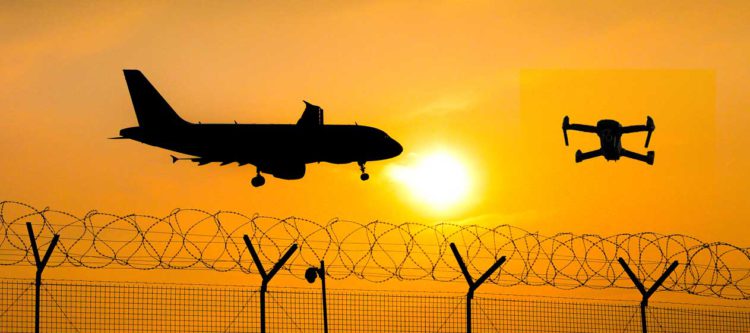Malicious drones – the UAS threat facing law enforcement and military

Unmanned ariel vehicles (UAVs) – which are more commonly referred to as “drones” – are practically everywhere today. They’re used by tourists and hobbyists to take incredible photos. Insurance companies use them to inspect the damage to homes and businesses following a natural disaster. Companies like Amazon are even exploring methods to use drones to assist in package deliveries.
But with this spike in drone usage comes challenges. Commercial drones have become a significant concern for military and law enforcement as incidents of careless misusage, military surveillance, and malicious activities have increased.
Companies like D-Fend Solutions are offering new technologies designed to help military and law enforcement organizations detect malicious UAVs, and even take control of rogue drones to prevent illegal activity.
The Last Mile recently spoke with Matthew Semovoski, Post Sales Support Engineer for D-Fend Solutions, to explore this intriguing technology and learn more about the challenges that law enforcement organizations and the Department of Defense (DoD) face when countering unmanned aircraft systems (UAS).
 The Last Mile (TLM): Can you tell our readers a bit about D-Fend? What does the company do, and who does it provide solutions for?
The Last Mile (TLM): Can you tell our readers a bit about D-Fend? What does the company do, and who does it provide solutions for?
Matthew Semovoski: D-Fend Solutions is the leading counter-drone, cyber-takeover technology provider. This technology enables full control, safety, and continuity during rogue drone incidents to overcome current and emerging drone threats across complex and sensitive environments. With hundreds of deployments worldwide, EnforceAir, the company’s flagship offering, focuses on the most dangerous drone threats in the military, public safety, airport, prison, and critical infrastructure environments.
D-Fend Solutions’ technology has been chosen as best-in-class, proving itself across many high-tier U.S. government agencies – including the U.S. military, federal law enforcement, homeland security, and international airports. EnforceAir’s unique RF Cyber-takeover technology allows for the takeover, control, and safe landing of rogue drones to ensure the smooth flow of communications, commerce, transportation, and everyday life.
TLM: Why is the UAS threat a problem for the U.S. government and military? Why would local and national law enforcement be concerned about drones? Why is the military concerned about drones?
Matthew Semovoski: UAS threats, particularly with the use of commercial drones, have become a significant concern in recent years, with a sharp increase in the number of incidents. These new threats pose a unique challenge for conventional and special operations forces, homeland security and law enforcement agencies, and airports that were the first adopters of counter-drone technology.
The current military conflict in Ukraine is just one of the latest examples where commercially purchased drones are being used widely for various military purposes, including surveillance and attack. Nefarious operators and state actors have found new ways to attach small explosive devices or other potentially dangerous payloads that threaten military and law enforcement personnel. These UAVs can also be used as an “eye in the sky” to collect intelligence on troop movements and formations, military base operations, or to aid in illegal smuggling operations.
Advancements in drone technology will continue to improve as the proliferation of drone use continues. Drones are becoming faster, cheaper, harder to detect, and easier to operate. With improved performance and battery life, many commercially available drones can fly further away from their operator and carry heavier payloads than ever before. These enhanced features pose major safety and security risks to every type of environment.
TLM: Why is it difficult to counter or defend against the malicious use of drones? What about the malicious use of commercial drones makes it inherently difficult for the military and law enforcement community to counter?
Matthew Semovoski: The adaptation of commercial drones for nefarious purposes, or their careless deployment and usage, poses new challenges that are different from the conventional state actor UAV threat for which traditional legacy C-UAS technologies were originally developed. Incidents in urban and other sensitive environments demand newer capabilities that avoid operational disruption, collateral damage, and support continuity.
Legacy, traditional C-UAS technologies continue to play a role in a layered defense strategy, but they may be inadequate in certain scenarios. On the detection side, radars can generate false positives from other flying objects, such as birds. Optical solutions are ineffective without a line of sight, and acoustic solutions do not operate well in noisy environments or with quiet drones. Directional finders do not always provide the most precise location, as their spatial resolution is limited.
In addition, there are further limitations on the mitigation side. Jamming, illegal in many sensitive environments, is temporary and may disrupt essential communications systems. Kinetic solutions involving physical intervention (e.g., a projectile) may cause severe collateral damage. Lasers can also lead to collateral damage, and their accuracy may be affected by weather conditions.
New generation C-UAS technologies can mitigate the risk of malicious drones by taking control of the situation, ideally with the hostile drone landing safely in a predefined safe zone. Cyber-centric, non-jamming, non-kinetic technology does not require line-of-sight, can distinguish between authorized and unauthorized drones, operates in autonomous modes, and comes in a wide variety of deployment configurations for complete operational flexibility, with open APIs for integration with various Command & Control (C2) systems
TLM: How does the D-Fend solution help military, law enforcement, and security organizations counter the UAS threat? What do D-Fend’s solutions do that others can’t?
Matthew Semovoski: D-Fend Solutions’ EnforceAir, flagship C-UAS solution, has been selected by defense agencies worldwide as a best-in-class radio frequency-based system. EnforceAir features proven and future-proof technology to detect, identify, and mitigate unauthorized rogue drones.
Unlike conventional counter-drone technologies, EnforceAir mitigates the drone threat without the risk of collateral damage and without disrupting other nearby communication systems. The system is passive during detection and identification, with minimal RF signature, reducing the potential of unintentionally revealing the location.
With the understanding that military and law enforcement personnel often use friendly drones to assist with operations, EnforceAir can differentiate between friend and foe, allowing authorized drones to continue operations without interruption. In addition to detecting and locating drone threats, EnforceAir can also identify the drone’s take-off and pilot position to aid military, law enforcement, and security organizations in pilot apprehension where appropriate.
In our next article on The Last Mile, we will feature the second half of our discussion with Matthew Semovoski focused on some recent news and partnerships that the company has announced, and how D-Fend technologies can leverage mobile mesh networking solutions to extend counter-UAS capabilities to off-grid locations.







No Comment